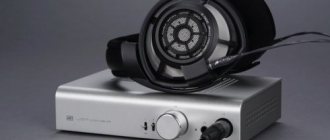Last year, HyperX rolled out a whole host of new headsets in a variety of price and user segments: from the esports Drone and mainstream Stinger to a true flagship that combines excellent sound and one of the best microphones: the HyperX Cloud Revolver. During this time, the company managed to collect enough feedback on the latest model to re-release it, adding a feature with virtual 7.1, while simultaneously improving it on all fronts.
What is virtual surround sound anyway? How can one even claim surround sound if a stereo headset’s hardware is almost no different from models with virtual surround sound? Let's try to answer all these questions in order, and at the same time see what has changed in Revolver, which received the letter S at the end.
How does sound work?
You can delve endlessly into the physical process of radiation and perception of sound waves, and write a large article, but we are analyzing a specific case, so we will limit ourselves to a simple and rather rough description: it is enough to remember the essence of the processes taking place.
In the case of sound reproduction by equipment, a powerful magnet is located in the center of the speaker. Its field can be used to be repelled and attracted to it by passing current through a coil of wire that is attached to a sound-emitting membrane. The sound source produces certain electrical vibrations, they pass through the coil, excite a magnetic field, it interacts with the corresponding field of the magnet and the coil begins to move, dragging the membrane with it. The movements of this structure back and forth affect the layers of air bordering it.
The result is waves diverging in all directions: low pressure, high pressure, low pressure, high pressure. Next, these waves penetrate our ear, interact with the eardrum, and then the reverse process occurs - the brain “decodes” the vibrations into what we understand as sound, and many years of training of the neuronal system allows us to understand speech, distinguish music from the sound of falling rubble, and so on Further.
The same thing happens when you hit, say, a stick on an empty barrel: the kinetic energy of the impact leads to vibrations of the surface, which shakes the air, and then according to the same principle.
Features and your budget
There are a few other things to consider when choosing the perfect sound system. Most of these things will depend on your budget versus the benefits of a better setup.
By and large, a 7.1 system will be more expensive than a 5.1 system. It contains more components and provides richer sound. However, there are various factors that will affect how expensive your system will be.
Receiver : To operate your sound system, you will need a receiver to convert the line level signals from the TV into speaker level signals for the speakers. Many 5.1 systems come with a receiver, but few 7.1 systems come included. While it's not as ideal as a set of matched 7.1 speakers, you can always start with a 5.1 system and later upgrade to a 7.1 receiver and two additional speakers.
Wiring : Another factor you may want to consider is how you are going to wire your sound system. Most systems have wireless capability, making it easy to install speakers in a room. However, what you gain in convenience, you lose in sound quality. Direct wired signals will always be of higher quality than what you can get from a wireless connection. Ultimately, you'll need to decide if the mess of wires you'll likely have to buy separately is worth it.
Calibration : There are many systems on the market that provide their own internal calibration. These systems optimize sound by sending test signals from each speaker to a microphone you set up in the main listening area of your room. These systems are more expensive and are more common with 7.1 systems.
Surround sound
The speed of sound in space is conditionally constant, depending on the density of the medium, but for the conditions of existence familiar to the brain, there is almost no difference in the speed of sound at high and low atmospheric pressure. Again, through evolution and maturation, the brain has learned to find patterns between the direction from which the sound came and the difference in signals between the right and left ears. In the case of nature, the difference in the arrival of sound to the left and right ear is provided by the source of vibrations itself. In films, sound sources are assigned at the creation stage, in games they are calculated in real time, relative to the position of the camera and the surrounding space, and if someone approaches you from behind, a signal is given to the corresponding sound channels, it goes to the speakers, which vibrate the air. The waves interfere with those reflected from the walls, emitted by other speakers, add and subtract, depending on the phase, and eventually reach the ears. Next, the brain, taught by life experience and centuries of evolution, understands that now it needs to give the command to its legs to “Run away,” or at least turn around and identify the source visually.
The nuances of surround sound
The human body carries several unique patterns. All people have different fingerprints, the iris of the eye and the shape of the ears, which practically does not change in the process of growing up: the size of individual parts of the ear may change, but its relief and internal structure are rather scaled and change slightly. From about two months of life, the brain begins to learn to use the ears for their intended purpose: hearing abilities develop, and throughout life it hones the skill of determining the direction of sound not only by the difference in sound vibrations arriving in time, but also by how the sound is reflected / absorbed by different parts auricle before reaching the eardrum. The mechanism is complex, but quite effective: it’s not just that most developed mammals have complex-shaped ears - reptiles, (in particular, snakes) are almost deaf and perceive a limited range of frequencies.
3D balance control
The typical scheme for adjusting the balance between channels also had to be modernized. It is based on a 4-channel scheme, widely used in car audio, and converted into three-dimensional, where the midpoints of all planes converge on one ground.
Assembled according to this scheme:
The result is a module like this. In order to assemble it, I had to get a lathe and turn some parts myself.
Ear examinations
A special mannequin that simulates the structure of the head and its behavior in terms of absorption, reflection and propagation of sound waves, a bunch of high-precision microphones, a room with a sound-absorbing coating, a train of teraflops, a dozen scientists and a lot of time spent on calculations, made it possible to create general patterns of change in the sound wave, coming to the ears. The difference between the output signal, the microphone next to the mannequin, and the microphones in the “ears” made it possible to determine how the human body affects the propagation of sound.
All this was necessary for maximum data cleaning from polluting influences. These data were then applied as a filter to the original data, and the main measurements were made with different ear models. The study looked for patterns between the shape of the outer ear and how signals coming from different directions are distorted - and they were found. It is these changes in the signal shape (averaged, of course) that are used to transform “regular” sound into “surround” sound when using stereo headphones without additional speakers.
Recording system
Now all that remains is to record live sound in the format we need, so that it all comes to life and gives the expected effect. I use MOTU Ultralite mk2 , and Terratek EWS88MT . The software is free Audacity .
My first model of a 3D microphone, to my regret, gave results far from expected.
It’s one thing to assemble 8 microphones into a certain structure, it’s quite another to isolate the microphones from each other, making each microphone hear only its own zone and not hear anything else. Otherwise, to obtain the desired effect during playback, the recorded sound will have to be digitally processed, and this will add even more problems with developing your own software.
And here my progress is delayed, ready-made phonograms in a similar format do not yet exist in the world, recording such a phonogram with sufficient quality is also problematic, all that remains is to continue researching.
PS While I was making my playback unit, in Germany the company Microtech Gefell had already made a microphone system for 3D recording M Cube
Works, but not perfect
The audio card in the remote control can operate in two modes: stereo and 7.1. The system doesn’t care how many speakers you actually have, it will provide seven channels of sound. The game engine or multimedia player will read this information and produce the appropriate sound panorama, sending the required audio stream to each channel. Next, the built-in chip comes into play: it adds the difference in signal arrival for the left and right ears and applies the average changes obtained from the studies. Unless you have very prominent ears, this process goes some way to tricking your brain into determining direction, although not as well as it does in a real environment.
HyperX Cloud Revolver S
The main difference between the S version and its predecessor is, of course, a new remote control with built-in audio, the ability to connect via USB and support for virtual 7.1, but in addition to these changes, something has been updated in the headset.
The design of the case remained the same, but the materials were changed, no more “game” black and red coloring. Many users liked the strict design of the mid-line CloudX headset, and the re-release of the flagship received the corresponding colors: classic black with gray/silver elements. The new model with a detached microphone looks like the average audiophile headphones in a techno style.
Improvements
The elastic characteristics of the headband have been revised: the steel bracket has become softer, and the new Revolver S does not squeeze the head as tightly. In a similar way, the parameters for the self-adjusting headband were re-selected. Taking into account all the changes, the headset sits much softer on the head and puts even less pressure on the brain.
The rest of the structure was left unchanged. The speaker cups have two degrees of freedom and adapt to any head shape, the ear pads and support arch are filled with polyurethane foam with memory effect, which is covered with high-quality leatherette with micro-perforation - the design breathes and wicks away moisture.
The headset fits perfectly on almost any head, automatically adjusts to the owner and allows you to comfortably communicate, play or listen to music for several hours in a row.
Communication
The microphone migrated without any changes. The same detachable flexible rod is used, the connection is made through a classic 3.5 mm connector. It holds its shape, can be easily straightened, and the reliable and moderately bendable body will prevent you from damaging the internal wire.
The element itself is still the same: electret, condenser, highly directional. Excellent sensitivity, noise reduction with a “beam” aimed directly at your mouth, built-in protection against blowing, and now also built-in microphone volume control in the USB remote control.
USB sound
The sound card is combined with a sound control panel. The design is minimalistic: three buttons (switching Dolby 7.1 mode, equalizer preset and turning off the microphone), three indicator LEDs, two large and convenient wheels for adjusting the volume of the incoming and outgoing audio signal. There is a clip on the back side, you can hang the remote control on your sleeve or collar, or you can attach it to the same USB cable and thereby shorten its almost endless (2+ meters) length.
Samsung HW-R550
A soundbar allows you to raise the sound quality of a simple TV to a higher level. Thanks to the bass boost function, the low frequencies are enhanced.
Main characteristics of the model
- standard: 2.1;
- dimensions of the main module (WxHxD): 904x55x80 mm;
- subwoofer dimensions (WxHxD): 201x353x290 mm;
- main module weight: 2.2 kg;
- subwoofer weight: 5 kg;
- total power: 320 W;
- number of columns: 1 pc.
Advantages
- + stylish design;
- + wireless connection supported;
- + the kit includes a convenient remote control with a minimalistic design;
- + you can control the soundbar using the Samsung TV remote control;
- + simple and clear controls, there are no complex functions;
- + crystal strong and powerful sound, no wheezing or other interference;
- + it is possible to add rear wireless speakers;
- + affordable price.
Flaws
- - no NFC;
- — the display is purely functional;
- — when connected via HDMI, the sound is quiet;
- — no Wi-Fi;
- — there is a second delay when switching modes and inputs.
Best deals
8.
Dolby 7.1
The mode is activated by pressing a single button (without it, the headphones mix the set 7.1 into stereo). It will work when connected to a PC or PS4 / PS4 Pro. It does not require any drivers, it is determined by the system out of the box, there is no need to install additional software. In films with multi-channel audio, the technology works well: the sense of direction of the special effect is enhanced, although not as radically as with “honest” surround sound.
In games, the effect is highly dependent on many factors. In racing simulators, I was able to hear the enemy “behind me” and feel from which side they were trying to get around me. In some shooters it was possible to more accurately determine the enemy's position by ear, but not in all. It was not always possible to understand the direction of the “diagonal” sounds: the opponent was in front-left or behind-left. In any case, the direction of movement itself is felt better than with a conventional stereo, and good. The opinions of friends who managed to listen to the headset were divided.
Some clearly heard the direction of the sound, others could determine the direction very conditionally: in front, on the left, on the right, sometimes behind. In the case of listening to regular content (for example, music), Dolby 7.1 will simply stretch the stereo base. There will be some sense of being in a large room with speakers rather than sound coming from headphones.
Playback system
It is built according to a scheme similar to conventional audio receivers and expanded to 8 channels.
The experimental sample is assembled in a housing from a Fostex 2016 mixer.
The input stage is assembled using typical UD708 op-amps that have been idle for many years.
The output stage is assembled on budget Chinese PAM8610, since 5-10W is enough for experiments.
On the right is the input power filter. On the left is an isolated DC-DC converter for powering operational amplifiers.
Equalizer presets
In the basic mode (all indicator LEDs are turned off), the headset does not interfere with the audio stream in any way: it reproduces what you listen to in the form in which it received the audio signal from the PC. The first mode is an increase in low frequencies, the second is a stretching of the mids and a general “flattening” of the frequency response, the third is an increase in the vocal range and sharpness of the sound.
One can be used for the corresponding musical genres, the other can be used to fine-tune the sound using the player’s software equalizer, and the last one can be used in games to better hear ringing sounds such as footsteps and the voices of party members.
Sound of music frequency response
Revolver S retains the sound feel of its predecessor. Uniform filling of low, mid and high frequencies, a small peak at 3 KHz, giving a feeling of “purity” of the sound. For relatively low-impedance headphones, the sound is surprisingly balanced. Rock compositions sound neat, guitars, vocals, drums - everything is heard extremely clearly, there is no feeling of being taken out of context or a clear dominance of one of the sounds over the other (at least on those tracks that are properly mixed by the sound engineer and balanced across the stage). Jazz and blues with brass aggressively burst into the consciousness, filling it with overtones and hoarse vocals, in which the “black” style of performance is immediately recognizable. Classical works and the playing of a modern orchestra are full-bodied and voluminous; when listening, you literally feel that subtle resonance of a mass of similar instruments playing in unison.
Listening to music is pleasant, and individual preferences for b o
More low or mid frequencies can always be compensated with an equalizer. Gaming applications require headphones to have a wide stereo panorama and a clear sense of sound direction, and the headset does this well.
The frequency response curve was measured by specialists from PCgames at a stand whose price is comparable to a good car. A mannequin of the head and torso, appropriate level of equipment for recording and analyzing the signal, compliance with all methods and several repeated measurements to average the obtained values and search for deviations.
Frequency response:
Distortion:
Balance:
LG SL8Y
The soundbar is characterized by support for 4K HDR and Dolby Vision technology. Now you can enjoy watching content in your own home theater without reducing the quality of the 4K picture. There is a built-in Chromecast, thanks to which you can play music from the most popular applications over Wi-Fi.
Main characteristics of the model
- standard: 3.1;
- dimensions of the main module (WxHxD): 1060x57x119 mm;
- subwoofer dimensions (WxHxD): 221x390x313 mm;
- main module weight: 4.4 kg;
- subwoofer weight: 7.8 kg;
- total power: 440 W;
- number of columns: 1 pc.
Advantages
- + powerful sound and attractive appearance;
- + it is possible to connect via optical, Bluetooth, HDMI;
- + easy and intuitive controls;
- + there are phone applications to use instead of the remote control;
- + the sound is good when watching movies, listening to music, playing games;
- + Dolby Atmos and DTS:X supported;
- + you can listen to music from your smartphone;
- + compatible with Google Assistant;
- + passing games reaches a whole new level;
- + there are many different functions.
Flaws
- — to connect Bluetooth, you need to additionally install Google Home;
- — the initial setup is very inconvenient;
- - a fairly large body.
Best deals
10.
TL;DR: HyperX Revolver S – fully charged
This is not the first time that the gaming division of Kingston HyperX listens to user feedback, carefully studies, analyzes and draws the right conclusions from the experiences of consumers of their products.
The headset was upgraded on all fronts, without “cutting” any of the existing advantages. Want a more mature, formal design? Here he is. The body is still the same, but no more bright red accents. Barely noticeable stitching with light threads, a silver logo and white sectors, which do not reveal the gaming origin of the gadget.
Complained that competitors have surround sound for the money? A universal audio card that works with PC and PlayStation is already included. This piece of hardware does not require special drivers and any software that consumes the resources of your computer, everything will work out of the box. And for owners of expensive audio cards and music lovers from mobile gadgets, the headset can still be connected via classic 3.5 mm connectors; an extension cord is included.
Did the headset cling too tightly to your head and did not want to come off, slowly zombifying the wearer and forcing you to distribute HyperX products among your friends? We dealt with the first one, but the second one, sorry, is not a bug, but a feature. It’s a sin not to recommend good gadgets to your party members; you have to defeat another world evil with them, but they again don’t hear anything.
Amazing sound and one of the best microphones in the headset industry are still here. Is it time to take stock?
YAMAHA MusicCast BAR 400
The soundbar supports MusicCast Surround and comes with a wireless subwoofer. This model is characterized by support for Dolby Digital and DTS Digital Sound formats. It is possible to create a full-fledged surround and powerful sound system if you additionally purchase speakers that support MusicCast wireless technology.
Main characteristics of the model
- standard: 2.1;
- dimensions of the main module (WxHxD): 980x60x111 mm;
- subwoofer dimensions (WxHxD): 180x417x405 mm;
- main module weight: 2.7 kg;
- subwoofer weight: 9.4 kg;
- total power: 200 W;
- number of columns: 1 pc.
Advantages
- + balanced sound for both movies and music;
- + conveniently manage through a proprietary application;
- + design without unnecessary elements;
- + there are Dolby, DTS, DTS Virtual:X decoders;
- + playing lossless audio files;
- + high quality workmanship.
Flaws
- - inconvenient remote control - not all functions are displayed;
- — no sound saving for different sources.
Equipment, price, where to buy
Full specifications and equipment of HyperX Cloud Revolver S:
Headphones
- Type: Closed, with self-adjusting headband;
- Weight: 360 g + microphone 16 g;
- Speaker: membrane diameter 50 mm, neodymium magnet core;
- Frequency range: 12 Hz – 28 KHz;
- Impedance: 30 Ω;
- Sound pressure level: 100.5dBSPL/mW at 1KHz
- Harmonic Distortion: <2%;
- Power consumption: standby mode - 30 mW, maximum - 500 mW;
Cable length and connectors
- Headset (4-pole 3.5 mm jack): 1 m;
- Audio card (USB): 2.2 m;
- Extension cable (2x3.5 mm connector): 2 m.
Microphone
- Sensing element: electret, condenser;
- Directional pattern: bidirectional, noise canceling;
- Frequency range: 50 Hz – 18 KHz;
- Sensitivity: -44 dbV (0dB=1V/Pa,1kHz).
They are asking for about the same amount for the updated model as they were asking for the old one: 12,990 rubles. And in early April, you will be able to personally touch, try on and listen to the headset throughout the HyperX partner network. Well, in order not to miss the start of sales, you can subscribe to notifications on the promotional page in Eldorado.
But it's better to hear once than to read a hundred times, so Kingston subscribers will be the owner of our flagship headset with mind-blowing surround sound. Therefore, if you have not subscribed yet, you need to correct the situation as soon as possible. We will choose a winner randomly and announce the lucky winner's nickname on April 7th. Don't miss the opportunity to get cinematic sound for your computer!











